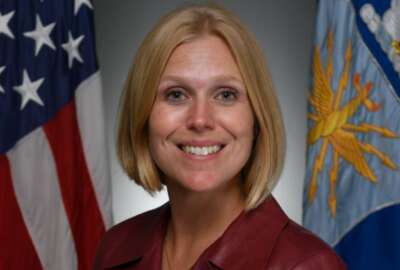Hubbard Radio Washington DC, LLC. All rights reserved. This website is not intended for users located within the European Economic Area.
Exclusive
New data strategy, OMB Circular to set foundation for OFPP’s Better Contracting Initiative
Christine Harada, the senior advisor in the Office of Federal Procurement Policy, said there are four areas of focus under the Better Contracting Initiative, in...
When it comes to federal contracting, sometimes what’s old is new and what’s new is better than before.
The Biden administration is resurrecting an enterprise software licensing initiative with more complete data and 20-years of understanding of it takes to be successful as part of its new Better Contracting Initiative.
Christine Harada, the senior advisor in the Office of Federal Procurement Policy, said this four-pronged effort aims to give agencies better data and better tools to extract more value from acquisitions.

“We are leaps and bounds ahead of where we were, especially since if you think about from the 2016 timeframe when I was here during the Obama administration, with the amount of data that we have across the federal enterprise,” Harada said in an exclusive interview with Federal News Network. “One of the areas of focus that we’re launching [Nov. 8] is around leveraging data, to be able to help get the lower prices and better terms, and certainly is one of the first pillars around that. And to that end, we’re launching a new centralized data management strategy supported by a new draft Office of Management and Budget (OMB) circular to facilitate a more robust sharing and analyzing of acquisition data across the federal enterprise. It’s not just about pricing, but also what are the terms and what are the conditions to be able to help provide that kind of context. It’ll also include enhanced market research, vendor performance and data to be able to strengthen the agency’s abilities to better negotiate their deals.”
Better, more accurate and more timely data is a central theme of BCI whether it’s through the revamped goal of creating enterprisewide software licenses or developing requirements for professional services contracts right the first time or reducing risks in sole source or other similar types of contracts.
“The Biden-Harris administration expects that the results of the BCI will generate more than an additional $10 billion annually in savings and cost avoidance while improving the performance of federal contracts,” OMB stated in the fact sheet.
Harada said OFPP will lean on current metrics used for category management as well as new ones that focus on some of the softer sides of the acquisition process.
“We’re going to be instituting a number of workshops through which we’re leveraging a process Department of Defense created, where they facilitated workshops to do peer reviews of a lot of these requirements and do that type of facilitated discussion. We will be working with GSA and a number of agencies to be able to support those agencies, in development of contracts for various professional services or other complex services,” she said. “We are looking to see for the dollars invested in these particular efforts, how did that translate into overall performance? Same thing also with the other work streams associated with getting better value at our sole source in other high risk contracts. For well over a decade, the DoD has conducted peer reviews to mitigate risks. I think that they’ve had some tremendous returns over that. Over the past four years, the department has used its price fighters group, a group cost and engineering experts that are available to help the department avoid hundreds of millions of taxpayer dollars over a four year period. It’s completely paid off for us in a big way.”
Back to the software future
The software license initiative for common titles builds off of experiences dating back to 2003 when the General Services Administration launched the SmartBuy program and 1999 when the Defense Department’s enterprise software initiative signed its first agreement.
Harada said the goal is to reduce price variance, secure most favorable terms and conditions and improve the federal cyber posture.
“Currently, prices routinely vary up to 20% for the same software across agencies,” OMB wrote in its fact sheet about BCI. “Under the BCI, GSA will lead the government in negotiating a governmentwide IT software license agreement with a large software provider. This change will help to reduce price variance, secure more favorable terms and conditions, and capture 25% in efficiency gains, avoiding the wasted effort of having each agency individually plan, research and negotiate for the same common requirement.”
The Defense Information Systems Agency also is taking on a similar initiative. Chris Barnhurst the deputy director of DISA, said on Nov. 6 at the Forecast to Industry day that a major focus for the agency is ensuring equitable pricing across DoD for software licenses.
“When we are receiving different prices for the same product based on the component in the department, we see that a lot times where vendors may give the Army a certain license per seat cost and come to DISA or the Fourth Estate and it could be 2-3-4 or as much as 12x more than the Army,” Barnhurst said. “We have engaged with the DoD chief information officer and the Office of Acquisition and Sustainment to think about what can do from policy perspective to drive government to speak with one voice with vendors, especially what we are using software as an enterprise. That is in process.”
Harada said this initiative builds on a lot of the work GSA has been doing with the transactional data reporting (TDR) program and the high definition acquisition data framework (Hi-Def), which aims to “enhance the efficiency of the entire acquisition process from budget and acquisition planning to contract closeout — and all phases in between — by providing users with the right data and information at the point of need without duplicating data, tools or effort,” states the Acquisition.gov site.
“The circular includes both a framework and a data environment that helps provide a little bit more of a coordinated approach to this. It also includes some governance information around how we’re all going to be collecting, working together collectively,” Harada said. “We’ve got a number of requirements in the circular that we’re going to be working collectively with the CAO community to make sure that they are being implemented. The circular also includes requirements for agencies to very actively contribute to existing knowledge portals on innovative techniques and emerging technologies, making sure that they are posting it and organizing it in a publicly available manner.”
New OMB guidance coming
OMB also will issue guidance directing agencies to use “a proven methodology to pinpoint requirements for high priority acquisitions. This protocol leverages agency facilitators to conduct acquisition workshops which help teams of program, acquisition, supply chain, IT and other experts translate their needs to each other and build performance-based requirements to capture better more cost-effective outcomes.”
Additionally, GSA will hold a series of facilitated requirements development and acquisition planning workshops for services contracts.
Around the fourth priority area, OMB will expand DoD’s “price fighters” effort.
“Between fiscal years 2020-2023, expert pricing advice offered during peer reviews helped the department realize cost avoidance of nearly $300 million with an investment of just under $2 million. Select civilian agencies that have significant sole-source contracting or priority programs with underperforming contracts will engage with the ‘Price Fighters’ or other engineering or cost experts to participate in inter-agency peer reviews,” OMB stated. “Agencies will also increase use of ‘hybrid’ contracts for appropriate acquisitions. This type of contract allows for multiple types of payment (e.g., cost-reimbursement, labor-hour, fixed-price) to better align with levels of risk during different parts of the lifecycle of a large acquisition for development and production.”
Industry reacts positively
OFPP held a session with industry representatives on Wednesday to detail BCI.
Roger Waldron, president of the Coalition of Government Procurement, said it’s good to see OFPP focus on many of the challenges and opportunities that have emerged in the federal sector over the last decade.
“It is good to see that leveraging data is the first strategic prong. Data will be essential to assessing the context of acquisition alternatives and the total cost of acquisition. Data also will be key to understanding the terms and conditions, competitive opportunities, and market conditions that provide context and drive value and savings,” Waldron said in an email to Federal News Network. “With GSA will play a leading role here, expanding Transactional Data Reporting (TDR) under GSA’s Multiple Award Schedule program will support the administration’s Better Contracting Initiative (BCI).”
Waldron added that OFPP’s focus on improving the requirements process is key to BCI.
“The BCI recognizes that sound requirements are foundational to positive outcomes in delivering best value mission support to customer agencies. Understanding agency unique requirements while leveraging commercial best practices enhances competition, increases efficiency and allows access to innovation from the commercial market,” he said.
Harada said the meeting with industry was productive.
“I think given the very tight fiscal environment that we are facing, this is something that they are thinking very actively about as well,” she said. “Relatedly when it comes to a possible shutdown in [eight] days, a vast majority of the brunt of these shutdowns are borne by the federal contracting community and so they too have very vested interest in ensuring that not only does Congress continue to do the work and appropriate and government, but also their livelihoods are absolutely intertwined with ours.”
Copyright © 2024 Federal News Network. All rights reserved. This website is not intended for users located within the European Economic Area.
Jason Miller
Jason Miller is executive editor of Federal News Network and directs news coverage on the people, policy and programs of the federal government.
Follow @jmillerWFED
Related Stories
High per-license cost pushed many military services, Defense agencies away from DEOS
Air Force’s corrective action fails to satisfy unsuccessful bidders for EITaaS contract
Related Topics
Acquisition
Acquisition Policy
All News
Better Contracting Initiative
Big Data
Christine Harada
Coalition for Government Procurement
Contracting
enterprise software licenses
General Services Administration
Industry
Office of Federal Procurement Policy
Office of Management and Budget
Roger Waldron
Technology





